Gene Revolution Turns 25 - 1
Gene-Altered Attitudes
Roger Beachy still remembers the excitement of planting the first genetically altered food crop into United States soils. It was the summer of 1987 when he, along with a team of Monsanto scientists, transplanted tomatoes modified to resist a virus at the company's research farm, near Jerseyville, Illinois.
"I believed we were seeding hope for a hungry world. We were working toward ways to reduce dependence on chemicals," said Beachy, then a scientist at Washington University, in St. Louis, Missouri.
It would take almost a full decade before transgenic plants gained a serious foothold in U.S. soils, and they would not be those the idealistic young scientist envisioned. Instead, corn, cotton and soybeans designed to resist pests and herbicides hit pay dirt, and the seed and chemical industry became entwined, creating a tsunami of changes throughout the private and public agriculture sectors.
In the next few weeks, DTN/Progressive Farmer is exploring the past and future of genetic engineering breakthroughs in agriculture. In this, the first story of our special series called Gene Revolution Turns 25, we look closer at the different attitudes about the gene revolution.
BITTERSWEET MEMORIES
Iowa farmer Bill Horan becomes almost giddy remembering the first days of Roundup Ready crops.
"It was incredible -- the most amazing thing that happened in my farming life," Horan said. "Before, I spent the whole summer spraying, hoeing and trying to save my crop, and Roundup eliminated that. It allowed me time to be a better manager, a better husband and father.
"Time is the most precious thing any human has, and this technology gave me more of it," Horan recalled. The technology also allowed less tillage and more soil-saving practices.
P[L1] D[0x0] M[300x250] OOP[F] ADUNIT[] T[]
Still, consumers had little to show from these early direct-to-farmer benefits. Perceptions of science tinkering with nature, corporate secrecy, well-organized and well-funded environmental campaigns, even weed and insect resistance combined to create a public relations nightmare that haunts the technology today.
Beachy, who serves on the National Science Board, calls the rejection of the science and increased regulatory requirements that resulted "arrogance of plenty." Cutting-edge tools that could have improved quality of life for many through vitamin-enhanced food, for example, are only now starting to be realized some 30 years later, he noted.
SECOND-GEN DISCUSSIONS
Gene-editing techniques now allow plant breeders to make specific and targeted improvements to a plant's genome blueprint and promise to provide more consumer benefits than the commercialized first-generation transgenic technologies. Will consumers be more willing to swallow low-gluten wheat that sidesteps sensitivities or sip coffee that has been saved from devastating disease?
Jim Blome, Calyxt chief executive officer, believes more information-sharing and transparency about the very definition of gene editing should help make the technology more palatable. Calyxt's heart-healthy, high oleic oil cleared regulatory hurdles in 2019 and became the first gene-edited food to reach market.
"In gene editing, we're not adding new chapters to the book. We're just editing the words in the chapters that are already there," Blome explained.
Jennifer Kuzma, professor and co-director of the Genetic Engineering and Society Center at North Carolina State University (NCSU), said history has shown how important it is to instill public confidence and lift the veil on how plants or plant products are modified.
USDA's SECURE (sustainable, ecological, consistent, uniform, responsible, efficient) rule, enacted in 2020, is expected to exempt gene-edited plants from USDA premarket field testing and data-based risk assessment if they meet specific criteria.
"Consumers want to know which products are genetically modified and which are not. I don't expect that to change for gene-edited crops," Kuzma said. "Crop developers, including companies, have signaled they want to do a better job with gene editing to improve public trust.
"If we simply say gene editing is a new breeding technique, and that we need it to revolutionize food and agriculture and that it provides benefits to the planet ... that's much the narrative formed in the early days of GMOs. We need to be informed by past communication mistakes to present a better future," she said.
In a recent Science article, Kuzma and her colleague, Khara Grieger, assistant professor at NCSU, recommended a framework for a non-profit coalition that would provide open access to information on all biotech crops in layman's language.
Sustainability and climate change will be big drivers in altering attitudes, Blome believes. "We have to do a better job of explaining these benefits and the extensive review and selection steps gene-edited products go through prior to market launch," he said.
**
Editor's Note: This is the first of the stories in our special Gene Revolution Turns 25 series. Next in the series: a look at how CRISPR's genetic scissors slice through crop problems to improve varieties.
Pamela Smith can be reached at pamela.smith@dtn.com
Follow her at @PamSmithDTN
(c) Copyright 2021 DTN, LLC. All rights reserved.






